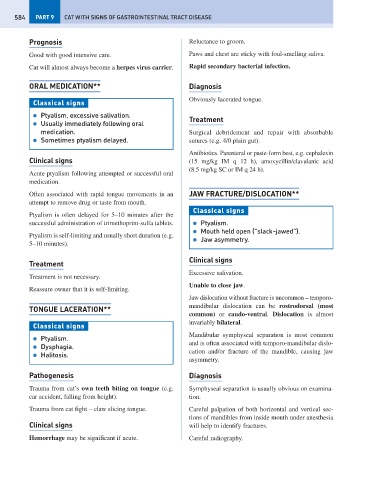Page 592 - Problem-Based Feline Medicine
P. 592
584 PART 9 CAT WITH SIGNS OF GASTROINTESTINAL TRACT DISEASE
Prognosis Reluctance to groom.
Good with good intensive care. Paws and chest are sticky with foul-smelling saliva.
Cat will almost always become a herpes virus carrier. Rapid secondary bacterial infection.
ORAL MEDICATION** Diagnosis
Obviously lacerated tongue.
Classical signs
● Ptyalism, excessive salivation.
Treatment
● Usually immediately following oral
medication. Surgical debridement and repair with absorbable
● Sometimes ptyalism delayed. sutures (e.g. 4/0 plain gut).
Antibiotics. Parenteral or paste-form best, e.g. cephalexin
Clinical signs (15 mg/kg IM q 12 h), amoxycillin/clavulanic acid
(8.5 mg/kg SC or IM q 24 h).
Acute ptyalism following attempted or successful oral
medication.
Often associated with rapid tongue movements in an JAW FRACTURE/DISLOCATION**
attempt to remove drug or taste from mouth.
Classical signs
Ptyalism is often delayed for 5–10 minutes after the
successful administration of trimethoprim-sulfa tablets. ● Ptyalism.
● Mouth held open (“slack-jawed”).
Ptyalism is self-limiting and usually short duration (e.g.
● Jaw asymmetry.
5–10 minutes).
Clinical signs
Treatment
Excessive salivation.
Treatment is not necessary.
Unable to close jaw.
Reassure owner that it is self-limiting.
Jaw dislocation without fracture is uncommon – temporo-
mandibular dislocation can be rostrodorsal (most
TONGUE LACERATION**
common) or caudo-ventral. Dislocation is almost
invariably bilateral.
Classical signs
Mandibular symphyseal separation is most common
● Ptyalism.
and is often associated with temporo-mandibular dislo-
● Dysphagia.
cation and/or fracture of the mandible, causing jaw
● Halitosis.
asymmetry.
Pathogenesis Diagnosis
Trauma from cat’s own teeth biting on tongue (e.g. Symphyseal separation is usually obvious on examina-
car accident, falling from height). tion.
Trauma from cat fight – claw slicing tongue. Careful palpation of both horizontal and vertical sec-
tions of mandibles from inside mouth under anesthesia
Clinical signs will help to identify fractures.
Hemorrhage may be significant if acute. Careful radiography.

